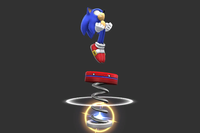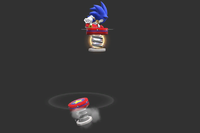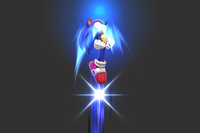Spring Jump: Difference between revisions
Smash Master (talk | contribs) m (→Summary: oops) |
|||
| Line 13: | Line 13: | ||
==Summary== | ==Summary== | ||
When used on the ground, the spring remains in place for a while, allowing other characters to use it, too. If this move is used in the air, the spring falls downwards, acting as a [[projectile]] that deals 4% damage and horizontal knockback, making it effective for edge guarding and especially [[gimp]]ing. Springing from the ground sends Sonic higher up than when using it in the air. After using this move, Sonic still retains the ability to use normal [[aerial attack]]s and [[air dodge]]s, but will be unable to use special moves until he touches the ground. Additionally, in ''Brawl'', this move does not allow Sonic to grab any ledges onstage (i.e. auto-sweetspot) until he is finished gaining vertical distance, making it dangerous for recovery if Sonic goes above a ledge and exposed to an edge-guarder, this was changed in ''SSB4'', as he can now auto-sweetspot ledges, making it a safer recovery. Barring any outside influence, the spring will remain on the ground long enough for Sonic to do three jumps off of, disappearing just as he makes his third jump. Unlike the Spring item, it will always face straight up, even on a steep slope. Sonic's [[down aerial]] sends him kicking downward at about the same distance as when he springs upward. | When used on the ground, the spring remains in place for a while, allowing other characters to use it, too. If this move is used in the air, the spring falls downwards, acting as a [[projectile]] that deals 4% damage and horizontal knockback, making it effective for edge guarding and especially [[gimp]]ing. Springing from the ground sends Sonic higher up than when using it in the air. After using this move, Sonic still retains the ability to use normal [[aerial attack]]s and [[air dodge]]s, but will be unable to use special moves until he touches the ground. Additionally, in ''Brawl'', this move does not allow Sonic to grab any ledges onstage (i.e. auto-sweetspot) until he is finished gaining vertical distance, making it dangerous for recovery if Sonic goes above a ledge and exposed to an edge-guarder, this was changed in ''SSB4'', as he can now auto-sweetspot ledges, making it a safer recovery. Barring any outside influence, the spring will remain on the ground long enough for Sonic to do three jumps off of, disappearing just as he makes his third jump. Unlike the Spring item, it will always face straight up, even on a steep slope. Sonic's [[down aerial]] sends him kicking downward at about the same distance as when he springs upward. | ||
Sonic can use Spring Jump to escape from juggling. Its fast start-up, distance and multiple options afterwards make it a reliable defensive move when his damage percentage is low. | |||
If Sonic bounces off a previously set Spring, even his own, it doesn't count as his third jump as long as he doesn't land on it immediately from his up special, so he can use Spring Jump immediately afterward, gaining a great deal of height, essentially two back-to-back up specials. | If Sonic bounces off a previously set Spring, even his own, it doesn't count as his third jump as long as he doesn't land on it immediately from his up special, so he can use Spring Jump immediately afterward, gaining a great deal of height, essentially two back-to-back up specials. | ||
Revision as of 17:40, May 12, 2017
- For the item in the Super Smash Bros. series, see Spring.
| Spring Jump | |
|---|---|
| Spring Jump Spring Jump in Brawl | |
| User | Sonic |
| Universe | Sonic |
| “ | Deploy and use a spring to jump high. | ” |
| —Smash for 3DS's foldout | ||
Spring Jump (スプリングジャンプ, Spring Jump) is Sonic's up special move, causing a spring from the Sonic series to immediately appear below him and shoot him up a great vertical distance.
Summary
When used on the ground, the spring remains in place for a while, allowing other characters to use it, too. If this move is used in the air, the spring falls downwards, acting as a projectile that deals 4% damage and horizontal knockback, making it effective for edge guarding and especially gimping. Springing from the ground sends Sonic higher up than when using it in the air. After using this move, Sonic still retains the ability to use normal aerial attacks and air dodges, but will be unable to use special moves until he touches the ground. Additionally, in Brawl, this move does not allow Sonic to grab any ledges onstage (i.e. auto-sweetspot) until he is finished gaining vertical distance, making it dangerous for recovery if Sonic goes above a ledge and exposed to an edge-guarder, this was changed in SSB4, as he can now auto-sweetspot ledges, making it a safer recovery. Barring any outside influence, the spring will remain on the ground long enough for Sonic to do three jumps off of, disappearing just as he makes his third jump. Unlike the Spring item, it will always face straight up, even on a steep slope. Sonic's down aerial sends him kicking downward at about the same distance as when he springs upward.
Sonic can use Spring Jump to escape from juggling. Its fast start-up, distance and multiple options afterwards make it a reliable defensive move when his damage percentage is low.
If Sonic bounces off a previously set Spring, even his own, it doesn't count as his third jump as long as he doesn't land on it immediately from his up special, so he can use Spring Jump immediately afterward, gaining a great deal of height, essentially two back-to-back up specials.
Customization
Special Move customization was added in Super Smash Bros. 4. These are the variations:
| 1. Spring Jump | 2. Double Spring | 3. Springing Headbutt |
|---|---|---|
| "Spawns a spring. When used on the ground, it sticks around and can be used by anyone." | "Doesn't spring as high, but the move can be used twice in a row without landing." | "Spring straight up and deliver a headbutt. The spring doesn't stick around, though." |
- Spring Jump: Default.
- Double Spring: Can create two springs, doubling the effectiveness, but with a sacrifice of height. The springs also disappear if they were on the ground.
- Springing Headbutt: The initial jump can deal damage, but the spring disappears if it's on the ground. The jump is also slightly lower.
Origin
Springs first appeared in Sonic the Hedgehog, and were either colored red or yellow, with the red springs bouncing Sonic higher than the yellow springs. They were usually used to allow Sonic to access higher parts of the levels, or, if the spring is sideways, allow Sonic to run faster. Springs have appeared in numerous Sonic games since. The design was changed in Sonic Adventure and has remained the same since. The new design features the spring being red and blue with a yellow star in the center. This design, however, first originated in Sonic the Hedgehog as the Bumpers in Spring Yard Zone were designed similarly. In Brawl and SSB4, its shape is based on the original spring, but its design is taken from Sonic Adventure.
Gallery
Spring Jump in Super Smash Bros. for Wii U.
Trivia
- If Sonic goes into a Barrel Cannon via this move, when he jumps after he lands, he will go into his helpless pose. This also applies to Snake whenever he enters a Barrel Cannon by using Cypher.
- The spring left behind by the attack is one of the few items that can't be swallowed.
- If Sonic grabs a ladder or custom stage spring after using this move, when he lets go, he still has the same falling animation and he can't use his Spring Jump or second jump.
- If the player performs a moveset swap with Fox as Sonic, a large, golden Arwing will appear rather than the spring when the attack is initiated.
- If Sonic is caped by Mario or Dr. Mario during the Spring Jump, he is able to use the move again.




